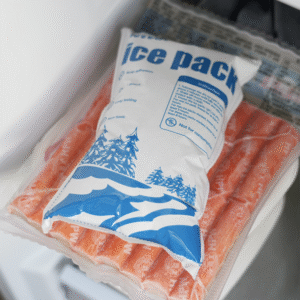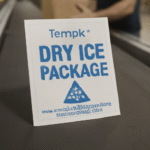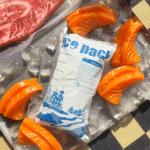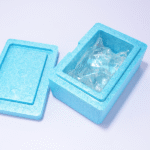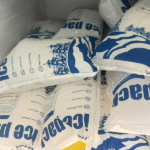Como usar bolsas de gelo seco para enviar frutos do mar com segurança: O 2025 Guia
O transporte de frutos do mar exige a manutenção de uma cadeia de frio rigorosa, especialmente quando se trata de produtos congelados. O uso de bolsas de gelo seco garante que os frutos do mar permaneçam na temperatura ideal durante o transporte, preservando seu frescor e qualidade. Este guia abordará como usar bolsas de gelo seco para transporte de frutos do mar em conformidade com 2025 regulamentos.
-
Quando você deve escolher bolsas de gelo seco para envio de frutos do mar?
-
Quanto gelo seco você precisa para vários períodos de envio?
-
Quais são as melhores práticas de embalagem para garantir o transporte seguro de frutos do mar?
-
Qual 2025 regulamentos e padrões de conformidade que você deve seguir?
Por que os pacotes de gelo seco são ideais para enviar frutos do mar congelados
Gelo seco, a forma sólida de CO₂, mantém um ambiente abaixo de zero, tornando-o perfeito para enviar frutos do mar congelados. Ao contrário dos pacotes normais de gelo ou gel, o gelo seco sublima sem deixar sujeira líquida, evitando o risco de queimadura de congelamento.
-
Temperatura do gelo seco: -78.5°C, ideal para manter frutos do mar a -18°C ou abaixo durante longos períodos de trânsito.
-
Duração: O gelo seco pode durar 24-48 horas por 5-10 libras, dependendo do isolamento e temperatura ambiente.
Para frutos do mar que precisam permanecer congelados, o gelo seco fornece o poder de resfriamento necessário para evitar descongelamento ou deterioração.
Gelo seco vs.. Pacotes de gel: O que você deve usar para frutos do mar?
-
Gelo Seco: Melhor para frutos do mar congelados, pois mantém os produtos em temperaturas ultra-frias. Por exemplo, atum ou camarão congelado que deve permanecer sólido durante todo o embarque.
-
Pacotes de gel: Ideal para frutos do mar frescos ou vivos, como lagostas ou peixes resfriados. Eles mantêm um ambiente de 0°C, que é frio o suficiente para manter os frutos do mar frescos, mas não congelá-los.
Para remessas de vários dias, uma combinação de ambos pode ser usada para equilibrar a estabilidade da temperatura. Pacotes de gel protegem o gelo seco, estendendo a duração do resfriamento e reduzindo a chance de queimadura de congelamento.
Embalagem adequada para envio de frutos do mar com gelo seco
Qual é a melhor estrutura de embalagem para gelo seco?
Para garantir que seus frutos do mar permaneçam seguros, use embalagens em camadas com ventilação adequada. Veja como embalar frutos do mar com gelo seco:
-
Enrole frutos do mar: Sele os frutos do mar em sacos selados a vácuo ou à prova de vazamentos para evitar o contato direto com gelo seco.
-
Use isolamento: Camada de espuma ou papelão ondulado para reduzir a exposição ao calor e retardar a sublimação.
-
Colocação de gelo seco: Coloque gelo seco na parte superior e inferior do refrigerador, mantendo-o isolado do produto para evitar danos causados pelo frio extremo.
-
Ventile o pacote: Certifique-se de que o recipiente não esteja hermético para permitir que o CO₂ escape.
Por que rotular & Desabafando Matéria
Rotulagem clara e ventilação adequada são essenciais para cumprir os regulamentos de transporte e garantir a segurança durante o transporte.
-
Rotulagem: A embalagem deve ser etiquetada com “Gelo Seco” ou “Dióxido de carbono, Sólido”, incluindo o peso líquido do gelo seco em quilogramas e marcações UN1845.
-
Ventilação: O gás CO₂ se expande durante a sublimação, portanto, é crucial fornecer um caminho de ventilação para evitar o acúmulo de pressão que pode levar à ruptura da embalagem.
Estimador de quantidade de gelo seco para remessas de frutos do mar
Para resfriamento confiável, estimar aproximadamente 5–10 libras de gelo seco por 15 litros de volume de remessa por 24 horas. Ajuste para tempos de trânsito mais longos ou temperaturas ambientes mais altas adicionando mais gelo seco.
| Tipo de contêiner | Gelo Seco (kg por 24h) | Melhor pista | Recomendações |
|---|---|---|---|
| Refrigerador pequeno (15 Quartos) | 2.5–3,5kg | Curta distância | Use pacotes de gel para frutos do mar frescos |
| Refrigerador de tamanho médio (30 Quartos) | 4.5–5,5kg | Longo curso | Garanta ventilação e isolamento adequados |
| Refrigerador grande (45 Quartos) | 5.5–8,0kg | Vários dias | Combine gelo seco com pacotes de gel para obter um perfil de temperatura mais suave |
Melhores práticas para embalar frutos do mar com gelo seco
-
Pré-resfrie o recipiente para reduzir a flutuação de temperatura.
-
Selar a vácuo ou glacear frutos do mar para evitar queimaduras de congelamento e perda de umidade.
-
Use divisórias rígidas separar gelo seco de frutos do mar.
-
Gelo seco de carga superior acima de uma divisória rígida, garantindo que o produto não esteja em contato direto com o gelo.
-
Ventile a embalagem: Permitir que o CO₂ escape não selando o recipiente hermeticamente.
Exemplo de caso:
Um exportador de frutos do mar usou 10 libras de gelo seco em recipientes de espuma com pacotes de gel para um trânsito de 48 horas. A remessa chegou a -18°C, sólido congelado, e livre de queimaduras de congelamento.
Principais regulamentos para envio de frutos do mar com gelo seco em 2025
O envio com gelo seco é regulamentado por diversas organizações para garantir segurança e conformidade.
-
IATA e 49 Cfr: As remessas de gelo seco devem aderir ao IATA PI 954 e o 49 CFR §173.217, que requerem rotulagem, ventilação, e restrições de peso.
-
USPS: As remessas aéreas estão limitadas a 5 libras de gelo seco, com marcação clara e requisitos de ventilação.
-
Padrões Federais de Segurança: Para Transporte Sanitário FSMA, garantir a documentação adequada dos controles de temperatura e manter registros para auditorias.
2025 Tendências no transporte da cadeia fria de frutos do mar
A cadeia de frio de frutos do mar está se tornando cada vez mais eficiente com os avanços na tecnologia de embalagem e no monitoramento de temperatura em tempo real. As principais tendências incluem:
-
Embalagens ecológicas: Novos isolamentos biodegradáveis e bolsas de gelo reutilizáveis.
-
Monitoramento de temperatura inteligente: Dispositivos de rastreamento em tempo real ajudam a garantir conformidade e transparência.
-
Isolamento VIP e Híbrido: Esses isolamentos avançados mantêm uma temperatura consistente em distâncias mais longas com menos gelo.
Perguntas frequentes
P: Por quanto tempo o gelo seco manterá os frutos do mar congelados durante o transporte?
-
O gelo seco pode manter os frutos do mar congelados por 24-48 horas, dependendo do isolamento e das condições ambientais. Ajuste as quantidades de gelo para tempos de trânsito mais longos.
P: Posso enviar frutos do mar vivos com gelo seco?
-
Não. O gelo seco pode congelar ou matar frutos do mar vivos. Use pacotes de gel para frutos do mar frescos ou vivos.
P: Quais etiquetas eu preciso para enviar gelo seco?
-
Marque a caixa com “Gelo Seco” ou “Dióxido de carbono, Sólido”, UN1845, NET KG, e garantir ventilação adequada.
Conclusão e próximos passos
Enviar frutos do mar com bolsas de gelo seco garante frescor e segurança durante a reunião 2025 padrões. Rotulagem adequada, embalagem, e a conformidade com os regulamentos são cruciais para o sucesso dos embarques de frutos do mar.
Plano de ação:
-
Calcular as necessidades de gelo com base no tempo de trânsito.
-
Escolha a embalagem certa e material de isolamento.
-
Rotule os pacotes corretamente e garantir o cumprimento.
-
Considere pacotes de gel para remessas prolongadas ou viagens de vários dias.
Contate a Tempk para uma consulta ou para otimizar suas soluções de cadeia de frio.
Sobre Tempk
A Tempk fornece soluções avançadas de cadeia de frio para exportadores de frutos do mar e empresas que precisam de embalagens confiáveis com temperatura controlada. Nossos produtos ajudam a garantir que suas remessas permaneçam frescas e em conformidade com 2025 regulamentos.
Chamado à ação:
Pronto para agilizar seu envio? Contate a Tempk para soluções personalizadas de cadeia de frio hoje mesmo.






